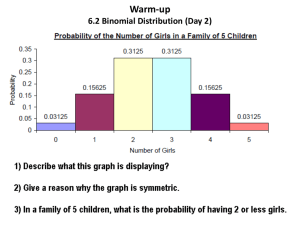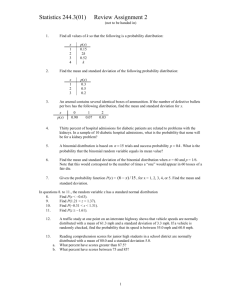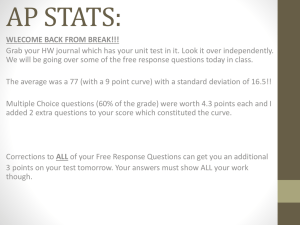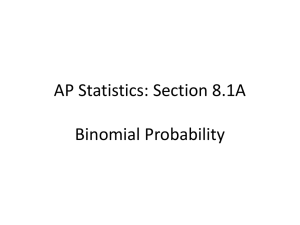Calculating Probability
advertisement
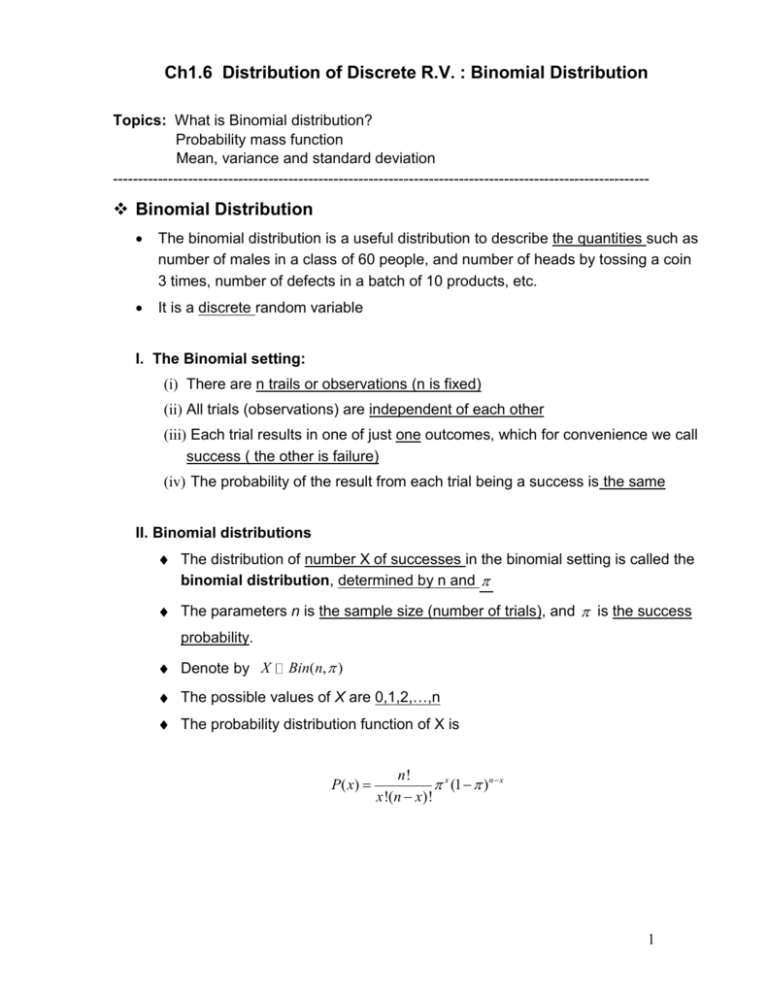
Ch1.6 Distribution of Discrete R.V. : Binomial Distribution Topics: What is Binomial distribution? Probability mass function Mean, variance and standard deviation ----------------------------------------------------------------------------------------------------------- Binomial Distribution The binomial distribution is a useful distribution to describe the quantities such as number of males in a class of 60 people, and number of heads by tossing a coin 3 times, number of defects in a batch of 10 products, etc. It is a discrete random variable I. The Binomial setting: (i) There are n trails or observations (n is fixed) (ii) All trials (observations) are independent of each other (iii) Each trial results in one of just one outcomes, which for convenience we call success ( the other is failure) (iv) The probability of the result from each trial being a success is the same II. Binomial distributions The distribution of number X of successes in the binomial setting is called the binomial distribution, determined by n and The parameters n is the sample size (number of trials), and is the success probability. Denote by X Bin(n, ) The possible values of X are 0,1,2,…,n The probability distribution function of X is P( x) n! x (1 )n x x !(n x)! 1 Where n!nn! x ! , and n k x! x x 1 x 2 3 2 1 . Notice that 0! 1 That is, P(x) is the probability of getting x successes out of n independent trials. Ex. Suppose that 20% of all copies of a particular textbook fail a certain binding strength test. Ten textbooks are randomly selected and let X denote the number copies that fail the test among the 10 selected textbooks. Then (1) Is this a binomial setting? ___ Fixed number of observations (n=10) ___ Independent observations ___ 2 possible outcomes only Fail the test vs. Pass the test ___ probability of “success” is the same for all observations (2) X ~ Bin(10, 0.2) (3) The probability distribution function of X is P( x) 10! 0.2 x 0.810 x x !(10 x)! (4) What is the probability that exactly 3 fail the test? P( X 3) P(3) 10! 0.230.8103 =0.2013 3!7! (5) What is the probability that at least 1 fails the test? P[ X 1] P[ X 1] P[ X 2] ... P[ X 10] 10! 1 P[ X 0] 1 P(0) 1 0.200.810 1 0.810 1 0.1074 0.8926 0!10! 2 III. Expectation, Variance and SD of X~Bin(n, ) X n X2 n 1 X n 1 Ex. In the textbook example, what are the mean number of failures and standard deviation? X n 10 0.2 2 X n (1 ) 10*0.2*0.8 1.24 Interpretation: On average, we would expect to have 2 textbooks that fail the test out of 10 textbooks. Ex. Assume 70% of all purchases at a certain store are made with a credit card. Assume each purchase is independent with each other. Let X be the number of purchases made with a credit card among 100 randomly selected purchases. (1) Is this a binomial setting? ___ Fixed number of observations ___ Independent observations ___ 2 possible outcomes only ___ probability of “success” is the same for all observations (2) X ~ Bin(n=100, =0.7) (3) Find mean and the standard deviation of the number of purchases made with a credit card out of 100 purchases: X n 100 0.7 70 X n (1 ) 100*0.7*0.3 4.58 3 Some practice problems: _______ 1. Which of the following are conditions of a binomial experiment? A) There is a sequence of n trials, where n is fixed in advance of the experiment. B) The trials are identical, and each trial can result in one of the same two possible outcomes, which we denote by success (S) or failure (F). C) The trials are independent, so that the outcome of any particular trial does not influence the outcome of any other trial. D) The probability of success is the same (constant) from trial to trial. E) All of the above are conditions of a binomial experiment. ________2. Approximately 14 percent of the population of Arizona is 65 years or older. A random sample of five persons from this population is taken. The probability that less than 2 of the 5 are 65 years or older is A) 0.8533 B) 0.1467 C) 0.4704 D) 0.3829 E) None of the above. ________3. A barbershop requires appointments for perms and hair cuts. Ten percent of those making appointments cancel or simply fail to show up. Next week's appointment calendar has 64 appointments. Let x be the number of missed appointments out of the 64. What is the expected number of cancellations and/or no-shows will occur during the next week? What is the standard deviation? 4



